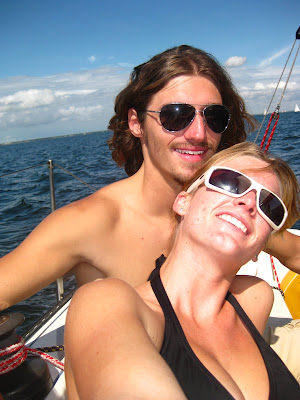



There was absolutely no breeze on Monday, but Tuesday brought 15-18 knots out of the south. This was perfect for a reach and run to DIYC in Tampa. Cody, Tweek and I started by motoring south down the channel and under the first bridge south of Eckerd, then hoisted the main and #4. We jib reached on starboard down the channel, then turned down into Tampa Bay and set the 1.5oz kite. With the #4 still up and trimmed loosely like a stay sail, the boat was very balanced on the 090 to 110 degree apparent wind reach and easily surfed the chop on the bay. It was nice to feel how fast the boat was downwind, as well as how dry she was too. We'll see if she stays dry sailing in the Pacific.
After about an hour of this, I saw there was a tear in the spinnaker and we dropped it before it could exploded. We set again, this time with the 1.5oz "chicken kite" with narrow shoulders, but by this point we had to turn down on a run to DIYC. Without the right spinnaker we were underpowered, but Furthur was still fast; Santa Cruz 27s love to go downwind. We pulled up to the hoist, Brian came to check out the boat, and Sheehan came to help us lift the boat and move the trailer with her Xterra.
On the drive back to Eckerd, a rain squall that had been hovering on the horizon during the whole sail hit and started pouring. We were all pretty happy that it didn't hit while we were out sailing.

























